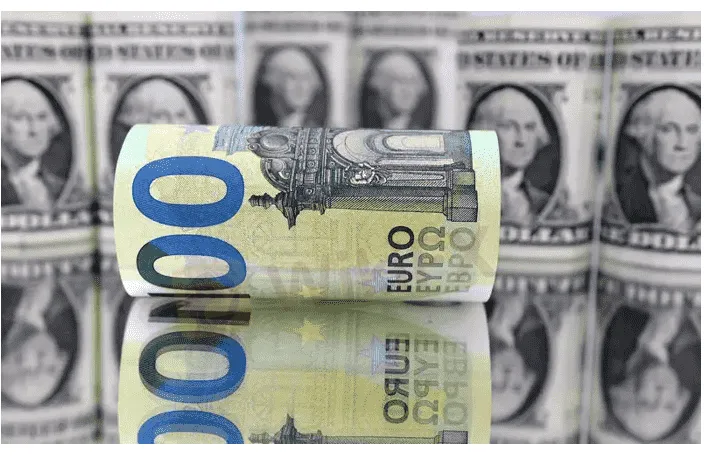简体中文
繁體中文
English
Pусский
日本語
ภาษาไทย
Tiếng Việt
Bahasa Indonesia
Español
हिन्दी
Filippiiniläinen
Français
Deutsch
Português
Türkçe
한국어
العربية
U.S. dollar share of global FX reserves rises in Q2; euro share slips
Abstract:The U.S. dollar’s share of currency reserves reported to the International Monetary Fund rose in the second quarter, with the Federal Reserve in the midst of an aggressive tightening cycle aimed at stamping out uncomfortably high inflation.

The greenbacks share of reserves rose to 59.5%, from 58.8% in the first quarter, IMF data showed on Friday.
The euros share, however, slipped to 19.8% in the second quarter from 20% in the first, declining for three straight quarters.
Global reserves, which are reported in U.S. dollars, are central bank assets held in different currencies used in part to support their liabilities. Central banks sometimes use reserves to help support their respective currencies.
“The new (IMF) figures illustrate the growing demand for the dollar as the Fed embarked on an aggressive tightening cycle which collided with Europes darkening growth outlook,” said Joe Manimbo, senior market analyst, at payments company Convera in Washington.
The dollar index rose 6.5% in the second quarter after advancing 2.4% in the first quarter, underpinned by the Feds policy tightening stance. So far in 2022, the greenback has surged 17% against a basket of major currencies, on track for its best yearly percentage gain.
The Fed, which has raised U.S. borrowing costs faster in 2022 than any time since the 1980s, has raised interest rates to a range of 3.0%-3.25%, from 0% in March. U.S. rate futures have priced in on Friday a 59.3% chance of another 75 basis-point rate increase.
In contrast, the euro zone has been hampered by an energy crisis, which has weighed on the euro even though the European Central Bank has been hiking interest rates as well.
In the second quarter, the euro dropped 5.3% versus the dollar.
The IMF data also showed the Chinese yuan‘s share of currency reserves edged up to 2.9% in the second quarter from 2.8% in the first three months of the year. In absolute terms, however, central bank holdings of the yuan fell 4.1% to $322.38 billion. The IMF started tracking the yuan’s share in 2017.
The yens share dipped to 5.1% during the period, compared with 5.3% in the first quarter. In dollar terms, yen reserves fell 8.3% to $578.52 billion.
IMF data also showed global reserves slid to $12.036 trillion in the second quarter, from $12.544 trillion in the first quarter. In the fourth quarter of 2021, reserves hit a record $12.92 trillion.

Disclaimer:
The views in this article only represent the author's personal views, and do not constitute investment advice on this platform. This platform does not guarantee the accuracy, completeness and timeliness of the information in the article, and will not be liable for any loss caused by the use of or reliance on the information in the article.
Read more

Top Benefits of Forex Cards
Forex cards enable you to make seamless transactions in foreign currencies when travelling abroad. Check out this guide to learn the benefits of forex cards in detail.

Mule Accounts: The Secret Weapon Fake Forex Brokers Use to Dupe Investors
Explore this story where we have highlighted how fake forex brokers use mule accounts to dupe investors.

Fraud Brokers List for July 2025- EXPOSED
Attention investors and traders! If you want to invest in the forex market, be careful not to choose these scam brokers. This warning list is issued by the Financial Conduct Authority.

Know the Major Risks of UbitMarkets, Before You Invest!
Scam brokers involved in the forex market who act genuine in the beginning but turn out to be frauds in the end. Choosing UbitMarkets could lead you to serious losses. Check out this article to know why we’re saying this.
WikiFX Broker
Latest News
America's Deficit Reckoning: How the U.S. debt spiral could spark a crisis
Treasury yields hold steady as Trump extends tariff deadline
Gold Prices to Fluctuate This Week Amid July 9 Tariff Deadline, Fed Policy
Top Wall Street analysts are pounding the table on these 3 stocks
Stock futures fall after Trump team says tariffs will go into effect on Aug. 1: Live updates
FCA clarifies expectations on bullying, harassment and violence to deepen trust in financial service
Asia-Pacific markets mixed after Trump shifts goalposts on tariffs again
XS.com Expands Global Reach with Landmark Kuwait Launch
S&P 500 futures fall slightly as Trump threatens new tariffs, Tesla shares drop: Live updates
10 Unlicensed Brokers Exposed – Check Now to Stay Safe!
Currency Calculator


